Is this just for nerds or do you as angler get something out of knowing how accurate you can measure the temperature? For some, knowing the temperature may change the day from a disaster to success.
Why be concerned about temperature, when going fishing? Is it an advantage or is just for data-addicted fishing reporters?
And if you like measuring the temperature, why just not go to a store and buy a waterproof thermometer. Is it really that simple?
Well, I will try to complicate things a little bit for you.
Celsius, °C
Anders Celsius, was Swedish, mainly known as a physician because he invented the scale for measuring the temperature in 1742 - the Celsius scale (°C).
During the 18th century scientists developed thermometers. The first one to make a satisfying model was Gabriel Daniel Fahrenheit.
Anders Celsius defined 100 °C as the melting point and the boiling point to 0°C (normal pressure). The opposite of today in other words.
In 1747 it was decided to switch the end points so that 0 °C became the melting point and 100 °C was set to the boiling point.
Fahrenheit, °F
Daniel Gabriel Fahrenheit was a German physicist. As Anders Celsius, Daniel Fahrenheit also had a temperature scale named after him, but many people found it to be anything but logical.
Fahrenheit developed one of the first precise thermometers using alcohol.
The coldest temperature attainable under laboratory conditions at that time, using a mixture of water, salt and ice, was defined by him as 0°F (approx. -17.8°C), but it there was an error in that definition, as it was not the lowest possible temperature he measured.
Fahrenheit also defined the human body temperature as 96°. Later, this was also found to be less accurate as the body temperature is 37 °C or 98.6 °F.
Even though the Fahrenheit scale was wrong at both defining points, it was widely used in Europe until the big switch to Celsius. The Fahrenheit scale is still used in the US.
Does the temperature matter?
Fishing on the right side of the edge of two different temperatures and knowing what temperature the fish prefer will help you change a disastrous day to a day to remember – a day where everything seemed impossible but you figured out where the fish were and how to fish them.
I know, that it is the angler with the fly in the water that catches more fish, but wetting the fly in the right water or area definitely helps.
How do you measure the temperature? Can we trust our thermometer?
These are some questions I will try to answer.
Temperature, bioactivity
The overall bioactivity somehow depends on the temperature. In most cases, higher temperature increases the activity to a certain point and then it starts collapsing under and just above the freezing point the biological activity is almost zero.
At 4 ºC something starts to happen and the activity and the chance of getting hooked to a nice sea trout increases and reach optimum between 11 and 13 ºC.
Pike also have a preferred range and I am sure these two species are not the only ones. During late winter and early spring, it may be of great interest to find warm areas close to the shore. One degree or maybe even 0.5 degrees may influence the fishing positively.
When the water heats up during late summer, the opposite is interesting. Now it is the colder bays and reefs with upwelling deep water, which keep the temperature lower that are in focus.
To get detailed knowledge to your area and know how wind, current, and other factors influence your waters temperature, you need a thermometer.
Temperature and salt
Saltwater has a higher concentration of salt than the fish itself. Therefore, water is being “pulled” out of the fish, which has to obtain water through the gills and filter the salt from the water to sustain certain “inside water-level”.
Some fishes are doing that in the most salty areas of the oceans while others never leave freshwater. Some other migrate from salt water to brackish water to freshwater, the sea trout i.e.
Other species may stay in the brackish water during summer like perch and pike and when Mr. Coolness paints the landscape with powder snow they re-enter fresh water. Their ability to adjust the salt/water concentration depends on the temperature.
The sea trout is also very sensitive. As long as the temperature is above 5 ºC it has now problems at all, but if the temperature drops it will rapidly seek for brackish water or even fresh water. The chance of getting a sea run brown during winter on the open shore is therefore close to nonexistent.
On the other side, if the temperature becomes too high it may inhibit the activity of the fish you are after.
So keep an eye on the temperature.
Temperature and oxygen
The temperature does also have an impact on the oxygen concentration. The lower temperature, the higher oxygen concentration. Wind, waves and the bio synthesises influence the oxygen level in saltwater. In streams, it is changed by riffles, white water, the amount of weed and the distance from the well. We will stick to the temperature only.
The solubility of oxygen drops as the water temperature rises. As you can see on the graph, the concentration is halved if the temperature is raised from 0 ºC to 30 ºC. That means you have to find an area, where the oxygen level is appropriate, the salt concentration is appropriate compared to the fish you are giving your interest and you may do some homework to find out what temperature the fish prefers - minimum, preferable and maximum temperature.
Temperature/fish tables are available in environmental reports, in books and on the Internet. So you can do some home work during the off-season. When done, you should get the equipment. You can find our take on different species and their temperature preferences as a graph here and in a table here.
F = (C - 32)/1,8
C = (F * 1.8) + 32
Buy One, but which?
Maybe you are now on your way to the nearest store to pick one up. They got plenty. You grab one. It looks great and shows 20,5ºC. Another thermometer of exactly the same kind and brand is lying next to it, but shows 20ºC. On a US scale may show 70ºF and another one 72ºF.
Which one to pick?
Well, if it is during summer I would prefer the one giving me a lower temperature as I might feel cooler and the fish more active…
If you do not work in a technical organization where you can calibrate your thermometer, it might be useful at least knowing how accurate it is.
How do you do that?
Boiling Point
This is not the way to go, as it is dangerous and you have to take the air pressure into your calculation.
Anyway, to see how good it is around the boiling point (100ºC or ) you boil some water in a pot and let the thermometer slip into it. Hold it upright down and use as much as the pot lit you can for keeping the environment as intact as possible.
BE CAREFUL – or simply, do not test your thermometer at this point. Several simply do not cover temperatures above 40ºC and you might therefore make it malfunctioning.
Again, how often do you fish in boiling water (well, I know that the water is boiling from fish from time to time…)?
Point Zero
The lower limit (0ºC or -32°F) is of much more interest and estimated by filling a thermo with crushed ice made of distilled water.
1.Add a small amount of distilled water so you get thick ice porridge. This mixture should fill up the thermos.
2. Wait a few minutes so you know the mixture has reached the freezing point.
3. Stick in the thermometer and read the temperature wait for 5-10 minutes.
The temperature on the thermometer should be 0ºC or -32°F. If your thermometer says one or two degrees higher, you now know you should subtract this when using it (– at least in the range close to zero).
This will give you a very accurate indication of how good your thermometer is and how big its uncertainty of measurement is.
Digital or Analogue
So, should you buy an analogue or digital waterproof thermometer? The first one I bought was one of these fridge-things, which did not like the rough fishing.
Then I bought an analogue, well-protected and waterproof one. The first thing I did was to check the point zero and found out, that it showed +1.5 degrees Celsius. That was OK and it had a seat in my wading jacket for quite some time.
However, one day I washed the jacket and forgot to take out the thermometer.
It did not like the hi-speed centrifuge...
The next thermometer I bought was digital. It worked very well, and it was easy to read the numbers. Besides that, it responded quickly but how accurate was it? As you may notice on the photos, it showed 0.0°C at the freezing point - spot on!
Choosing the right thermometer?
There are different thermometers to choose from. A zip lock bag and thermometer for the fridge will cost you about 2 US$. It will probably not last forever and you will have to seal the lid before using it so the paper scale will not fall apart.
Next step might be an analogue water proof shock resistant one. They come in different sizes, colors, and brands. They are very durable and the uncertainty of measurement is easy to compensate for. Most of them measure from well below the freezing point and into tropical temperatures. The prizes typically start at 30 US$.
If you want luxury, you should buy a digital thermometer, which responds quickly, is easy to read and accurate. They are expensive though, but will satisfy your need for correct data in your journals. Besides, they often have a build-in Fahrenheit-Celsius converter. Prizes start at 50 US$.
Now, go fishing and do not forget to have the temperature in mind.
- Log in to post comments


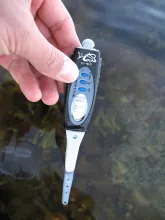
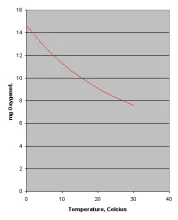
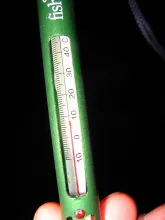
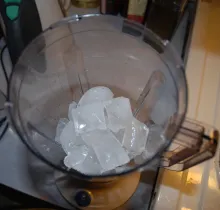
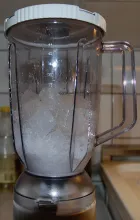
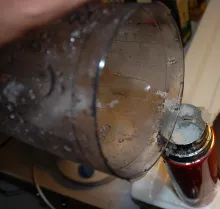
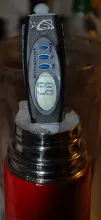
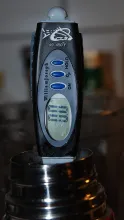
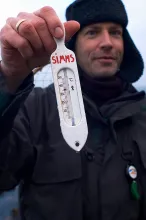
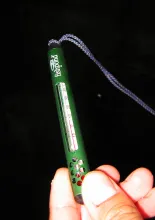
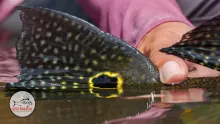



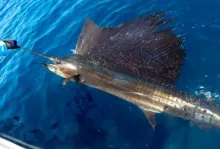
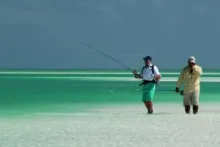

Infrared thermometer
Infrared thermometers measure surface temp only. If you aim it at a pane of glass it measures the glass temp. I am an HVAC tech and use thermometers a lot. I have a digital pocket therm. it is accurate and durable (tool box tough) and only cost $15-20 US
Infrared are expensive. Mine was around 250 $US and I wouldn't bring it on the water.
John,
I haven't t
John,
I haven't tried a p&s thermometer yet. How accurate are they? How you compared the two?
Kasper
Kasper,
Have you
Kasper,
Have you looked into the point and shoot infrared type. No more bending over or waiting. I have found that since I now have this one, I am more likely to use it and also use it more often. Same company as your digital one.